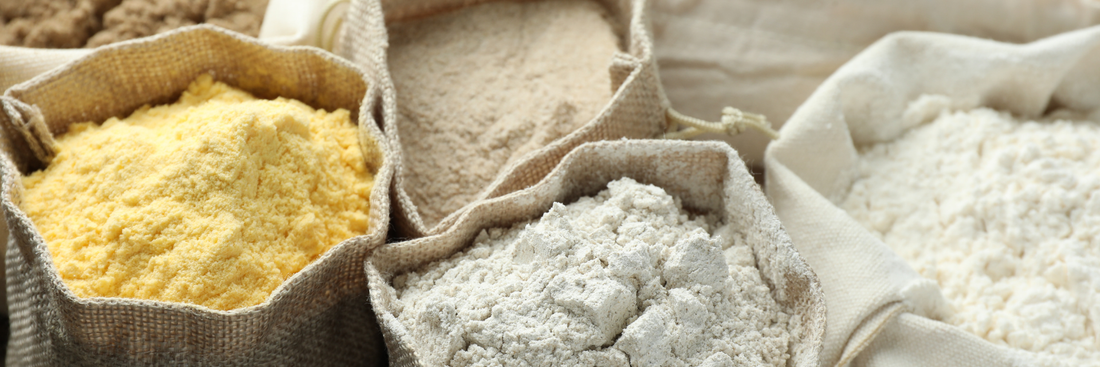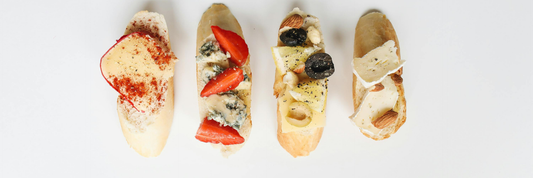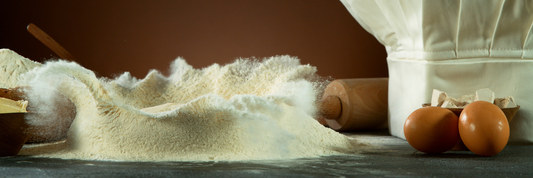Flour is the foundation of baking it determines the texture, rise, and structure of everything from crusty sourdough loaves to delicate sponge cakes. For professional bakers and pastry chefs, understanding the different types of flour and how they behave is key to mastering consistency, quality, and flavor.
In this guide, we’ll explore every major type of flour from classic wheat-based flours to modern gluten-free alternatives and help you choose the right one for your recipe and business needs.
-
Does Flour Go Bad? How to Tell, How Long It Lasts, and What to Do
-
Best Pastry Flour: Ultimate Guide to Choosing the Perfect Flour for Your Baking
-
Semolina Flour: What Is It? Recipes Using Semolina Flour
Understanding Flour: What It Is and How It’s Classified

At its simplest, flour is ground grain most often wheat that contains starch and protein. When mixed with water, certain proteins (mainly glutenin and gliadin) form gluten, which gives dough its elasticity and structure.
Different types of flour vary by:
- Protein content (affects strength and elasticity)
- Extraction rate (how much of the grain is milled)
- Bleaching and enrichment
- Type of grain (wheat, rice, almond, etc.)
These variables explain why bread flour produces a chewy texture, while cake flour yields tenderness and lightness.
Main Types of Wheat Flour

All-Purpose Flour
All-purpose flour (AP flour) is the most versatile flour type, with a protein content of about 10–12%. It balances structure and tenderness, making it ideal for cookies, muffins, pancakes, and quick breads.
- Best for: cookies, quick breads, pancakes
- Protein content: 10–12%
- Substitutes: cake flour or bread flour, depending on the recipe
Bread Flour
Bread flour has higher protein (12–14%), creating strong gluten networks that trap gas and give structure to yeast breads.
- Best for: artisan loaves, baguettes, pizza dough, bagels
- Protein content: 12–14%
- Tip: Add vital wheat gluten to AP flour to mimic bread flour.
Cake Flour
Cake flour is a finely milled, low-protein flour (6–8%) often chlorinated to improve absorption and whiteness. It creates tender, soft cakes with a fine crumb.
- Best for: sponge cakes, chiffon cakes, cupcakes
- Substitute: 1 cup all-purpose flour – 2 tbsp + 2 tbsp cornstarch
Pastry Flour
With 8–9% protein, pastry flour bridges the gap between cake and all-purpose flour. It delivers flakiness for pastries and crispness for pie crusts.
- Best for: tarts, cookies, scones, croissants
- Substitute: blend 1 part cake flour + 2 parts all-purpose flour.
Whole Wheat Flour
Whole wheat flour includes the bran, germ, and endosperm providing more fiber, nutrients, and flavor. It absorbs more water, resulting in denser doughs.
- Best for: hearty breads, rustic loaves, muffins
- Protein content: 13–14%
- Tip: Combine with bread flour for better rise and lighter texture.
White Whole Wheat and Wholemeal Flour
Made from a lighter wheat variety, white whole wheat flour retains nutrition but has a milder taste and lighter color than traditional whole wheat.
00 Flour
Italian “00 flour” is a finely milled wheat flour used for pizza, pasta, and pastries. Its “00” classification refers to fineness, not protein. Protein ranges from 8–12% depending on the brand.
Best for: pizza dough, pasta, focaccia
Semolina and Durum Flour
Derived from durum wheat, semolina flour has a coarse texture and yellow hue. Its high protein and gluten strength make it perfect for pasta, couscous, and certain breads.
Best for: pasta, gnocchi, rustic bread crusts
Self-Rising Flour
Self-rising flour includes added baking powder and salt, designed for quick baking projects. It’s common in biscuits and pancakes.
Formula: 1 cup all-purpose flour + 1 ½ tsp baking powder + ¼ tsp salt

Alternative and Gluten-Free Types of Flour
For customers with gluten intolerance or those experimenting with unique flavors, gluten-free flours offer endless possibilities. However, they differ in structure, absorption, and flavor often requiring a blend for best results.
Rich in fat and protein, almond flour creates moist, nutty baked goods.
Best for: macarons, low-carb baking, gluten-free cookies.
Highly absorbent and fiber-rich. Use extra eggs or liquids when substituting.
Best for: keto and paleo baking.
Rice Flour
Neutral taste, smooth texture; common in Asian baking and frying.
Varieties: white rice flour, brown rice flour.
Naturally sweet and rich in fiber; easy to make by grinding oats.
Best for: muffins, cookies, gluten-free blends.
Chickpea (Besan) Flour
Earthy flavor, high in protein, excellent binder.
Used in: flatbreads, batters, vegan recipes.
Other Gluten-Free Options
Buckwheat flour, teff flour, quinoa flour, sorghum flour, tapioca flour, cassava flour.
Each adds unique nutrition and texture often used in blends.
Ancient Grains and Specialty Flours

Interest in ancient grains continues to grow among artisan bakers.
- Spelt Flour: mild, nutty, lower gluten strength.
- Einkorn Flour: ancient wheat, buttery taste.
- Emmer & Kamut: dense structure, high mineral content.
These specialty flours cater to craft bakeries seeking distinct flavor profiles and health-conscious consumers.
Protein Content of Flour — Comparison Table
| Type of Flour | Protein (%) | Best For |
|---|---|---|
| Cake Flour | 6–8% | Light cakes, cupcakes |
| Pastry Flour | 8–9% | Pies, cookies, croissants |
| All-Purpose Flour | 10–12% | Everyday baking |
| Bread Flour | 12–14% | Yeast breads, pizza, bagels |
| Whole Wheat Flour | 13–14% | Rustic loaves, high-fiber breads |
| 00 Flour | 8–12% | Pasta, pizza dough |
| Semolina / Durum Flour | 12–13% | Pasta, flatbreads |
Choosing the Right Type of Flour for Baking
Your choice of flour directly impacts:
- Texture: chewiness vs tenderness
- Rise: gluten strength and hydration
- Flavor: whole grains, nuts, or refined flours
When developing new recipes, test different flour blends and monitor absorption rates and mixing times. Even small protein variations can affect dough handling.
How to Store Flour Correctly
Flour is sensitive to moisture, light, and pests. Proper storage ensures freshness and prevents rancidity, especially for whole grain or nut flours.
Storage tips:
- Store in airtight containers.
- Keep in a cool, dry place (or refrigerator/freezer for long-term storage).
- Shelf life:
- White flour: up to 1 year
- Whole wheat or nut flour: 3–6 months (refrigerated)

Substituting Flours: Quick Reference
| If you don’t have… | Use instead |
|---|---|
| Bread flour | All-purpose + 1 tsp vital gluten |
| Cake flour | AP flour – 2 tbsp + 2 tbsp cornstarch |
| Self-rising flour | AP flour + baking powder + salt |
| Whole wheat flour | ½ AP + ½ whole wheat blend for lighter texture |
Common Baking Issues Caused by Wrong Flour Type
| Problem | Possible Cause |
|---|---|
| Dense cake | Too much gluten (used bread flour) |
| Flat bread | Weak gluten (used low-protein flour) |
| Dry muffins | High absorption (whole wheat or coconut flour) |
| Gummy crumb | Excess moisture in gluten-free blend |
Testing, weighing ingredients precisely, and understanding each flour’s hydration properties are key to professional consistency.
International Naming Differences
| Region | Equivalent of All-Purpose Flour | High-Protein Flour Term |
|---|---|---|
| USA | All-purpose | Bread flour |
| UK | Plain flour | Strong flour |
| Italy | Type 0 or 00 | Manitoba flour |
| Germany | Type 405 (AP), 550 (bread) | — |
| Japan | Hakurikiko (cake), Chuurikiko (AP) | — |
Nutrition Comparison of Different Flours
- Whole wheat flour: High in fiber, vitamin E, and minerals.
- Refined white flour: Lower nutrients, longer shelf life.
- Nut and seed flours: High fat, protein, and micronutrients.
- Gluten-free flours: Varied nutrition, often fortified.
Professional bakeries increasingly highlight nutritional transparency an advantage when marketing artisan products.
How Flour and Packaging Connect in the Baking Industry
For bakery owners, the quality of your flour is just as crucial as the packaging that protects it. Using eco-friendly packaging (such as paper bread bags, kraft boxes, or compostable cake containers) preserves freshness while reinforcing your brand’s sustainability values.
Flour defines your product quality; packaging defines how your brand is perceived.
FAQs
What are the main types of flour?
The main flour types are all-purpose, bread, cake, pastry, whole wheat, semolina, and gluten-free flours like almond or rice flour.
What is the difference between all-purpose flour and bread flour?
Bread flour has higher protein (12–14%) for stronger gluten, while all-purpose flour has 10–12%, offering a softer crumb.
Can I substitute cake flour for all-purpose flour?
Yes, mix 1 cup AP flour – 2 tbsp + 2 tbsp cornstarch. The texture will be slightly denser but acceptable.
What is 00 flour used for?
Italian 00 flour is used for pizza and pasta, known for its fine texture and balanced protein.
Which gluten-free flour is best for baking bread?
Use blends combining rice flour, tapioca, and potato starch for better rise and elasticity.
How should flour be stored?
Keep flour in airtight containers in a cool, dark place; refrigerate whole-grain or nut flours for longevity.
Conclusion
Understanding the different types of flour allows bakers to master texture, flavor, and consistency from artisan loaves to delicate pastries. Whether you use high-protein bread flour for structure or fine cake flour for softness, the right choice makes all the difference.
And when you’re ready to share your creations with customers, remember sustainable packaging solutions protect your product quality and reflect your bakery’s craftsmanship and values.







